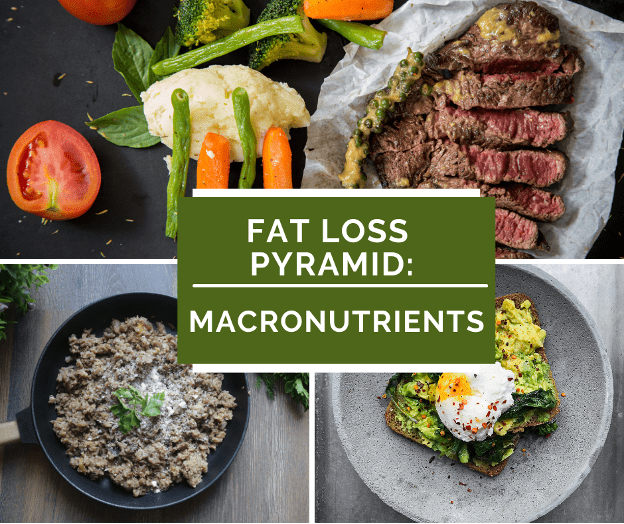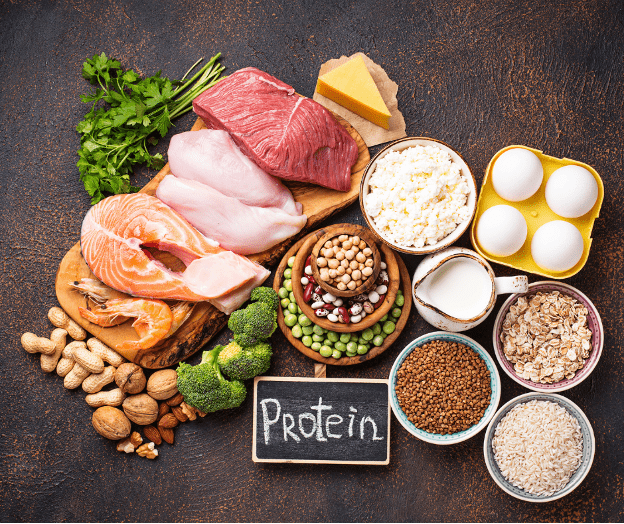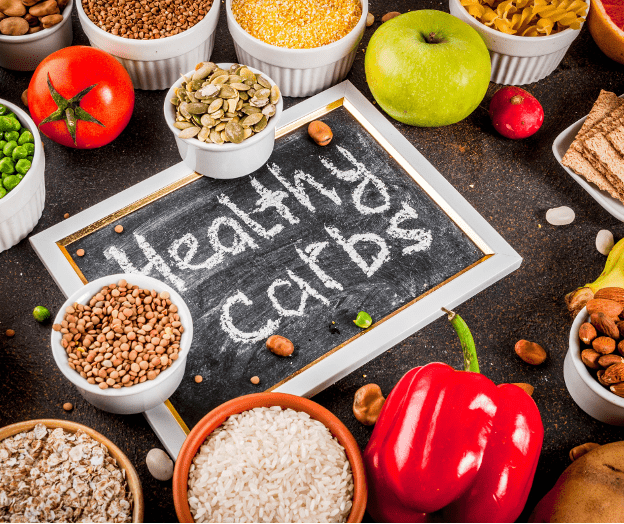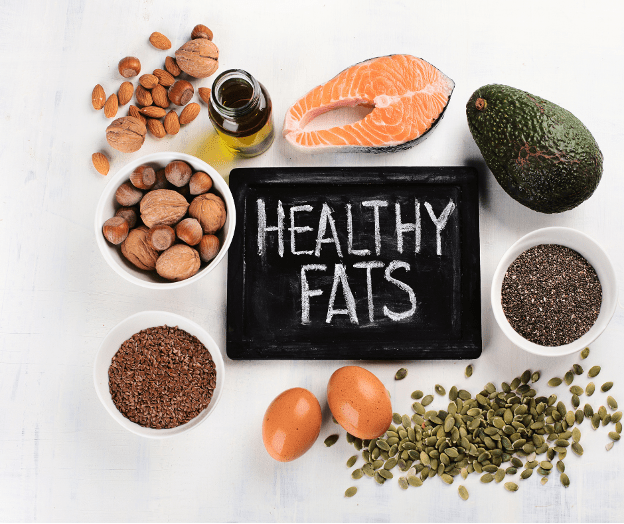
Fat loss pyramid : macronutrients
In the first blog post of this series, the first element of the fat loss pyramid covered was being in a caloric deficit. We all know that calories come from food, but more specifically they come from macronutrients, making this the next most important piece to the puzzle. There are 3 types of macronutrients: protein, carbohydrates, and fats. Not one macronutrient is superior to the rest. Each one serves its own purpose. However, from a fat loss standpoint, the breakout of these macronutrients must be taken into consideration when seeking a physical transformation. In this post, I’ll cover why macronutrients matter in your fat loss journey as well as their benefits, and some options for each. Not only will this understanding of macronutrients assist you in achieving your health and fitness goals, but it will also help you feel overall better along the way.
How many times have you tried going on a diet and ended up feeling hungry all the time? That is one of the top reasons why it can be so difficult to stick to a diet. You don’t feel fully satisfied and you are in a constant state of hunger, which truth be told can put one in a mood (guilty!). Next thing you know, you’re reaching out for those foods you know you shouldn’t be eating as much of. You become caught in a vicious cycle of going in and out of all sorts of diets.
PROTEIN
Here is where macronutrients matter. When it comes to feeling fully satiated, protein is your best friend. It is the most satiating macronutrient of the three followed by carbs with fats being the least. And here is why- protein favorably alters hormone levels triggering a physiological response that creates a sense of fullness. One of these hormones that influence hunger is ghrelin. Ghrelin increases your appetite so naturally, you want the levels of these hormones to stay at bay. This is exactly what protein helps accomplish. Studies have shown that after eating a high amount of protein, ghrelin was reduced at a higher rate than carbs or fats. That’s why incorporating more protein in meals is beneficial- the hunger hormones are kept low after their consumption.
Just as there are hunger hormones, there are also hormones that are known for promoting that sense of fullness. The production of these satiating hormones has been proven to increase after eating a high-protein meal. As you can see, this combination of hormones (ones that reduce hunger and the others that increase satiation) results in feeling fuller when eating higher protein meals than with the other two macronutrients. This makes it ideal when you are trying to stay full on a lower-calorie diet.
Not only is protein the most satiating of the three macronutrients- but it is also the most thermogenic. Your body burns off more calories from the consumption of protein than with the other two. This is due to the multiple steps that go into the nutrient processing of proteins, which includes digestion, absorption, transportation, metabolism, and storage. Yet again, protein for the win!
If those aren’t enough reasons to begin incorporating more protein into your diet, let me share these last ones. When you are strength training, muscle fibers are being torn. The damage to the fibers might sound undesirable but it’s actually just part of the process of building muscle. Protein is the building block for muscles, aids in this process. This is why the consumption of protein becomes essential to repairing those damaged muscle fibers and leads to hypertrophy (increased muscle mass). Not only does protein help in building muscle, but it also helps preserve lean muscle. This is crucial during this fat loss phase. Being in a caloric deficit usually means some muscle may be lost in the process, which makes it very important to hold on to as much lean muscle as possible. For one, lean muscle burns more calories while you are at rest. Think about that- by just having more lean mass on you, you’ll already be burning extra calories without having to do anything! On top of that, lean muscle is what helps you attain that more toned physical appearance.
This, however, is not a free pass to increase protein from just any source. Lean protein should be your main choice because it tends to have a low-calorie density makeup. Eggs, egg whites, seafood, white-meat poultry (chicken breast, turkey breast), and low-fat dairy are some great sources of lean protein. There are protein sources with a higher content of fat, and consequently higher calories. Some examples of higher-fat protein that you should limit include red meats especially those labeled “prime”, bacon, and sausage. Ideally, you want to spread out the protein across all of your meals throughout the day to maximize its absorption. You don’t want the bulk of your protein in just one meal.
As with anything, you have to be cautious not to overconsume. As mentioned earlier- macronutrients have calories. One gram of protein and carbs is equivalent to 4 calories while fat nearly doubles at 9 calories per gram. If you are increasing your protein intake, inevitably you are also increasing the total amount of calories you are consuming. Therefore, you need to make sure you are still staying within your calorie target range in order to remain in a caloric deficit. Otherwise, the extra protein becomes extra calories that you don’t need and is therefore counterproductive to your fat loss goal.
So how much protein should you be consuming on a daily basis? This will depend on your activity level. A general rule of thumb is to eat between 0.8- 1 grams of protein per pound of body weight. Getting the right amount of protein is even more important when you are weight training because as mentioned, you need the protein to repair and build muscle. The following are recommended dietary guidelines provided by The Food and Nutrition Board of the Institutes of Medicine for each macronutrient as a percentage of total calories: protein (10-35%), carbs (45-65%), fat (20-35%). As you can see, the range is somewhat broad which is why it’s more helpful determining the total protein intake needed based on grams per body weight. Once you determine how many grams of protein you need on a daily basis based on your weight, you can allocate the remainder of the calories between carbs and fats.
(See the example towards the end for further explanation.)
You do need to be careful not to overdo the protein because significant overconsumption can lead to kidney issues as a result of acid buildup. To help restore acid-base balance, you can eat foods high in potassium, and supplement with glutamine or sodium bicarbonate. An increase in protein can also cause constipation for some individuals, which is why it is recommendable to increase fiber intake when you begin consuming more protein.
CARBS
Let’s move on to everyone’s favorite macronutrient- carbs! As opposed to popular opinion, carbohydrates are not the enemy. In fact, you need carbs in order for your body to function optimally as it is the body’s preferred fuel source. It will always be the first macronutrient your body uses as a source of energy. It gives our bodies an immediate hit of energy, which makes carbs great to consume before and after workouts.
Now before you start reaching out for just any carbs, you must know that not all carbs are created equally. There are two different types of carbohydrates: simple and complex. It’s the simple carbs that have given carbohydrates a bad reputation as they tend to be processed foods. These types of carbs are now the most abundant and easily attainable in grocery stores. These are the ones you want to limit. They are low in nutrients, they make you feel tired, and they have a high glycemic index (which quickly raises blood glucose levels). Complex carbs, on the other hand, are high in fiber and nutrients. These are the carbs that will help you feel fuller for longer and have a low glycemic index. Whole grains, fruit, and vegetables are just a few examples of healthy complex carbs.
FAT
Believe it or not, fats are actually very essential. The brain is at least 60% fat so it is crucial for good brain health. It helps protect the body’s organs and supports cell growth. Additionally, it is integral to building sex hormones like DHEA, testosterone, and estrogen. For these reasons you still need to keep fats in your diet. The key is selecting high-quality fats. Similar to carbs, there are “good” fats (unsaturated fats) and there are “bad” fats (saturated and trans fats). You want to opt for unsaturated fats such as nuts, avocados, or foods containing omega 3s and omega 6s. It’s advisable to limit saturated and trans fats because high consumption of these has been linked to bad cholesterol (LDL), which increases the risk of cardiovascular disease. Recall that fats have double the calories per gram compared to protein and carbs (9 calories vs 4 calories) and are the least satiating of the macronutrients. Although you don’t want to completely eliminate fats from your diet, it is still something to consider as you plan how much fat to keep in your diet.

Calculating your calorie intake for each macronutrient:
The number of calories you need to take depends on various factors such as current weight, sex, height, age, body fat, activity level, and your overall fitness goal. This example is only to help you understand how you would go about calculating your total calories for each type of macronutrient as well as how many grams of each, once you know the total calories you need on a daily basis. Take for example a 125lb female who determines that her daily calorie target is 1,700 calories. She decides that she wants to go on a higher protein diet by eating 1 gram of protein per pound, which means she needs to consume 125 grams of protein per day. 1 gram of protein has 4 calories. Therefore, 500 (125 x 4) of her daily calories will come from protein. This leaves her with 1,200 calories to eat from either carbs or fats. How might one go about allocating the rest of these calories? Well, we know that 29% (500/1,700) of her calories are coming from protein. Let’s assume she decides that she wants her carbs to make up 40% of her calories and fats to be 31%. Given that 1 gram of carbs is equivalent to 4 grams of calories and 1 gram of fat has 9 calories, she can eat 680 calories (170g) from carbs and 520 calories (58g) from fats. Keep in mind that this is only an example for illustrative purposes. This is not suggesting that this is the most ideal breakdown as that will vary by an individual and overall goal.
At this point, it is very helpful to start thinking about which sources of food from each macronutrient you want to include in your diet. What are some recipes you can create from these ingredients? You will find that planning your meals ahead of time will be immensely helpful to staying on course. This could include making a grocery list with all the items you need and cooking some meals in advance. It might seem like a lot of effort in the front end, but your future self will thank you!
Author: Liliana Figueroa










